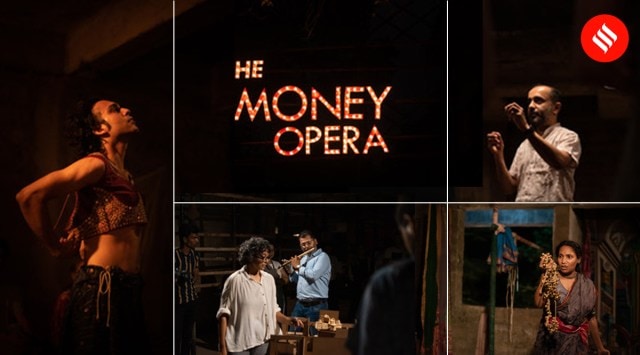📣 For more lifestyle news, click here to join our WhatsApp Channel and also follow us on Instagram
In an abandoned building in Goa, Amitesh Grover creates a layered piece on capitalism, titled The Money Opera
Rising from the ashes: “The Money Opera contains songs and stories of ambition, guilt, fear, desire, love, community, and many others that reveal the nature of contemporary society — what it keeps hidden, oppressed, and buried,” reads the director’s note.
 The whole show is live and there are multiple performances happening at the same time. (Photos: Radhika Agarwal)
The whole show is live and there are multiple performances happening at the same time. (Photos: Radhika Agarwal) At the Serendipity Arts Festival in Goa in 2019, Amitesh Grover presented an unconventional way of looking at the life of the great Habib Tanvir — between courses of food at a long table. The 2020 edition of Serendipity was held online and Grover created an interactive performance, The Last Poet, which unfolded in a seemingly endless labyrinth of rooms and came unsettlingly close to the worries of real life.
This year, Serendipity is back on the ground. Grover, as if to celebrate the vast potential of the analogue world, has created one of his biggest works yet, The Money Opera, which goes for the jugular of one of his major worries, capitalism. He has critiqued its various forms in almost every work till now, including Notes on Mourning, which featured a traditional Oppari singer from Tamil Nadu to show that the post-capitalism world does not allow us to mourn a loss for too long.
“The Money Opera contains songs and stories of ambition, guilt, fear, desire, love, community, and many others that reveal the nature of contemporary society — what it keeps hidden, oppressed, and buried,” reads the director’s note. Over the phone from Goal, Grover talks about the new work:
How did you conceptualise The Money Opera?
I came to Goa six months ago to look at abandoned sites and buildings and finally chose one. It is a five-storey building that has been lying empty for about 10 years. It has half-built walls. It is a site that is sinister in some ways, it carries the burden of a an unfulfilled past. It is as if it is yearning for a future that is not there. What is also interesting is that this is prime real estate that is worth about Rs 6 crore. So, there is the spectre of money and wealth that haunts the building. The case of ownership is under litigation. For me, the site became the central item of the piece that has been written by Sarah Mariam.
View this post on Instagram
Tell us about the cast of the performance.
There are professional actors as well as real-life professionals who are not actors. I was looking for a stockbroker. So, I finally met a stockbroker who handles the financial portfolios of the 20 richest Goan families. It’s a very interesting performance in which he talks about how most people don’t understand money or wealth creation and how he handles a portfolio of several thousand crores. On the other hand, I met a Konkani poet, who brought out a first collection of poetry last year that is a beautiful collection of anti-system poetry. She holds the audience complicit and talks about corruption of land and mining, among others. There is an ecologist, who talks about the tribal movements and an oceanographer who talks about a new species of ocean creatures that survives on toxic materials.
One of the features in The Last Poet was that the audience had to choose which performance to attend and could go from one room to another. How is The Money Opera structured?
The whole show is live and there are multiple performances happening at the same time. An audience member can go up and down the floors, discover different characters and stories. They choose how long they want to stay with one story and with one character, and there are moments of interaction and participation in the building itself.
View this post on Instagram
How did you turn an abandoned and neglected site into a performance space?
It’s been very hard to work in that abandoned building as we’ve had to deal with heat waves, rain and water-logging. We had lots of dust and insects. It was infested with rodents, and different kinds of creatures living inside. A team of safety and civil engineers of about 10 people worked consistently at the site to make it slightly more habitable for the artists to work. With scenographer Asim Waqif, we could transform the site to make it habitable for theatre.
Will people who are not in Goa ever be able to see it online?
It won’t be possible to document this piece since all the performances are happening simultaneously. It’s not a linear narrative and not just one story. But I’m getting a 15-minute short film made on the play that will carry interviews. I have to add that I do this deliberately. I think the power of theater in this world of media is that it should resist documentation, of being turned into a digital file. When I create physical theater, I ensure that I am creating an entire universe or a world of immersion and participation. The immediacy of it cannot be captured on media.
📣 For more lifestyle news, follow us on Instagram | Twitter | Facebook and don’t miss out on the latest updates!
📣 For more lifestyle news, click here to join our WhatsApp Channel and also follow us on Instagram







- 01
- 02
- 03
- 04
- 05





















